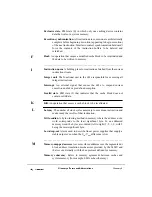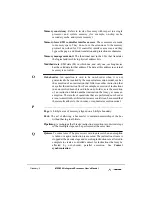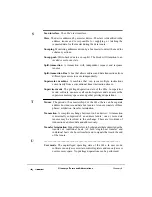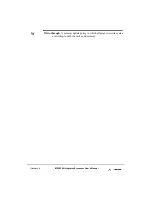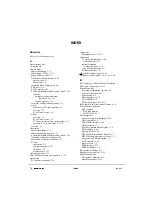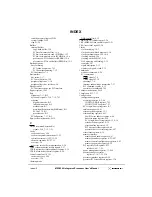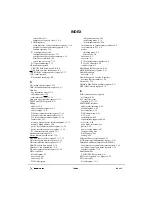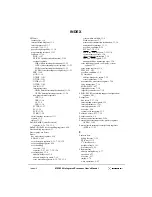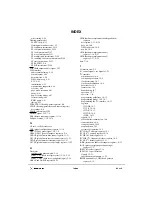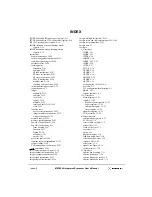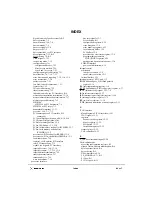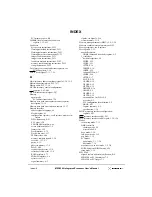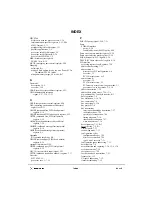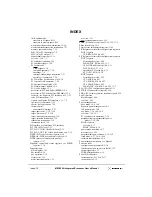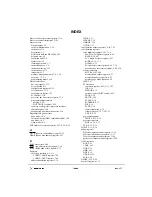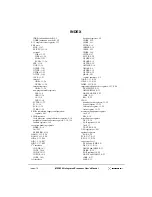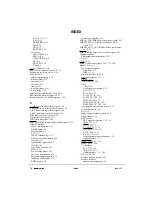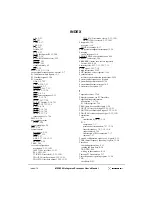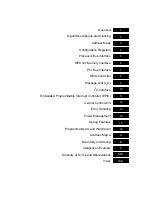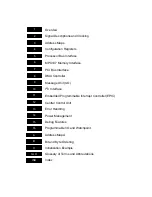
INDEX
Index Index-5
Floating-point model
FE0/FE1 bits, E-15
floating-point unit overview, 5-7
FP arithmetic instructions, D-19
FP compare instructions, D-20
FP load instructions, D-23
FP move instructions, D-23
FP multiply-add instructions, D-20
FP rounding/conversion instructions, D-20
FP store instructions, D-23
FPR0–FPR31, E-4
FPSCR instructions, D-20
FOE (flash output enable) signal, 2-23
FPM interface
address mulitplexing, 6-50
block diagram, 6-46
data interface, 6-54
DMA burst wrap, 6-61
ECC, 6-62
initialization, 6-55
organizations supported, 6-48
overview, 6-46
page mode retention, 6-61
parity, 6-61
power saving modes, 6-67
refresh timing, 6-66
RMW parity, 6-61
timing, 6-56
FPR0–FPR31 (floating-point registers), E-4
FPSCR (floating-point status and control register)
FPSCR instructions, D-20
FRAME signal, 2-12, 7-9
FRR (feature reporting) register, 11-16
Full-power mode, 1-18, 14-4
G
G2 core, see Processor core
GCR (global configuration) register, 11-16
GNT (PCI bus grant) signal, 2-8, 7-4
GPR0–GPR31 (general purpose registers), E-4
GTBCR (global timer base count) register, 11-21
GTCCR (global timer current count) register, 11-21
GTDR (global timer destination) register, 11-23
GTVPR (global timer vector/ priority) register, 11-22
H
Hard reset
configuration pins sampled, 2-38
HRST_CPU (hard reset (processor)), 2-26, 2-26
HRST_CTRL (hard reset (peripheral logic)), 2-26
HASH1 and HASH2 registers, E-22
HID0 (hardware implementation-dependent 0)
registers
description, 5-13, E-24
doze bit, 14-4
DPM enable bit, 14-4
nap bit, 14-5
HID1 (hardware implementation 1)
HID2 (hardware implementation 2)
I
2
C control signals, see Signals, 2-25
I
2
C interface
arbitration loss, 10-6
arbitration procedure, 10-5
clock stretching, 10-7
clock synchronization, 10-6
data transfer, 10-5
features list, 10-1
handshaking, 10-7
operation, 10-3
overview, 1-16
programming guidelines, 10-13
programming model, 10-2, 10-7
programming the I
2
registers
I2CADR, 10-7
I2CCR, 10-10
I2CDR, 10-13
I2CFDR, 10-8
I2CSR, 10-11
signals, 10-2
slave address transmission, 10-4
start condition, 10-4
start generation, 10-14
stop condition, 10-5
system configuration, 10-2
I2CADR (I
2
I2CCR (I
2
I2CDR (I
2
I2CFDR (I
2
C frequency divider) register, 10-8
I2CSR (I
2
IABR (instruction address breakpoint register), E-23
IACK (processor interrupt acknowledge)
IDSEL (ID select) signal, 2-16
IEEE 1149.1 specifications
signals, 15-21
specification compliance, 15-22
IFHPR (inbound free_FIFO head pointer)
Summary of Contents for MPC8240
Page 1: ...MPC8240UM D Rev 1 1 2001 MPC8240 Integrated Processor User s Manual ...
Page 38: ...xviii MPC8240 Integrated Processor User s Manual TABLES Table Number Title Page Number ...
Page 48: ...xlviii MPC8240 Integrated Processor User s Manual Acronyms and Abbreviations ...
Page 312: ...6 94 MPC8240 Integrated Processor User s Manual ROM Flash Interface Operation ...
Page 348: ...7 36 MPC8240 Integrated Processor User s Manual PCI Host and Agent Modes ...
Page 372: ...8 24 MPC8240 Integrated Processor User s Manual DMA Register Descriptions ...
Page 394: ...9 22 MPC8240 Integrated Processor User s Manual I2O Interface ...
Page 412: ...10 18 MPC8240 Integrated Processor User s Manual Programming Guidelines ...
Page 454: ...12 14 MPC8240 Integrated Processor User s Manual Internal Arbitration ...
Page 466: ...13 12 MPC8240 Integrated Processor User s Manual Exception Latencies ...
Page 516: ...16 14 Watchpoint Trigger Applications ...
Page 538: ...B 16 MPC8240 Integrated Processor User s Manual Setting the Endian Mode of Operation ...
Page 546: ...C 8 MPC8240 Integrated Processor User s Manual ...
Page 640: ...INDEX Index 16 MPC8240 Integrated Processor User s Manual ...







